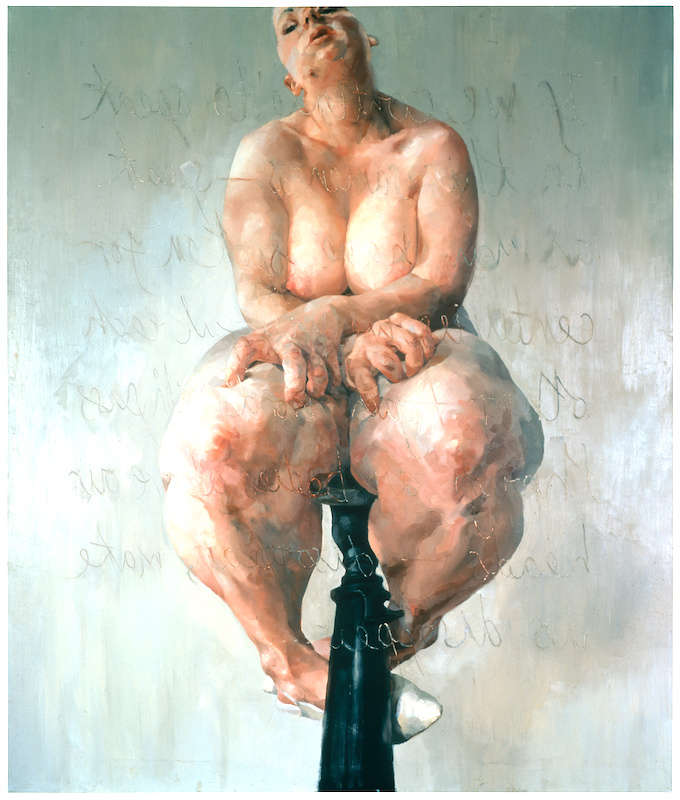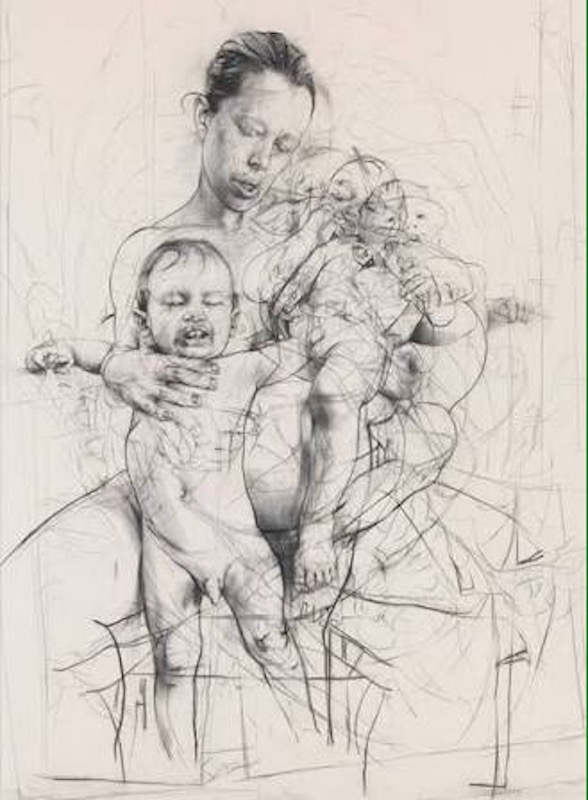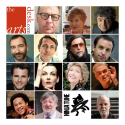When in the 1990s, Jenny Saville’s peers shunned painting in favour of alternative media such as photography, video and installations, the artist stuck to her guns and, unapologetically, worked on canvases as large as seven feet tall. While still a student at Glasgow School of Art, she painted Propped, 1992, one of the most challenging and memorable female nudes in the history of art (pictured below right).
This enormous painting confronts you on entry to her retrospective at the National Portrait Gallery, and it is still a knock out. Perching awkwardly on a tiny pedestal is a mountainous woman. Her hands claw at her thighs as though trying to tear away the voluminous flesh. From her elevated position, she defiantly stares us down and also, as it were, the illustrious history of the female nude – all those beauties who, over the centuries, have offered their bodies for our delectation.
Scrawled into the paint in mirror writing is a quote from feminist author Luce Irigaray: “if we continue to speak in this sameness, speak as men have spoken for centuries, we will fail each other again”. Clearly, Saville is not speaking (painting) like a man.
 This wondrous nude challenges the cannon in several ways – by showing extreme discomfort under our gaze and also daring to look back and, self-evidently, by not conforming to traditional standards of beauty. Presented to us as a thinking subject rather than a desirable object, she exemplifies the anguish of inhabiting a body that is not considered attractive.
This wondrous nude challenges the cannon in several ways – by showing extreme discomfort under our gaze and also daring to look back and, self-evidently, by not conforming to traditional standards of beauty. Presented to us as a thinking subject rather than a desirable object, she exemplifies the anguish of inhabiting a body that is not considered attractive.
Although the subject may not be regarded as beautiful, Saville’s paint work is to die for. While still at college, she had already mastered the depiction of flesh in oils. More than 30 years later, though, Propped is still her best painting. She was blown off course in 1977, I would say, by a visit to the studio of the late Willem de Kooning.
She was inspired by the freedom of his paint handling and his drive towards abstraction. It gave her the impetus to loosen her own brushwork and introduce abstract elements in an attempt to create some tension by disrupting the figurative image. “That’s a powerful space to work in,” she says, “between those two elements (the abstract and figurative). If I can get that right, it feels good, and it’s worth the journey.”
I don’t see her getting it right, though. Whereas in Propped the figure is built from coherent brushmarks with the tension coming from the confrontational subject matter itself; in paintings like Drift, 2020-2022 (main picture), the image of the head is constructed in one language and loose brush marks are sloshed over and around it in another. The result feels schizophrenic; instead of a dialogue, there’s merely confusion.
 Her drawings of another traditional subject – mother and child – are wonderful, on the other hand. Inspiration came from old masters such as Leonardo da Vinci and Raphael, but instead of showing the Madonna in an idealised state of serene passivity, Saville portrays motherhood from actual experience – as hard work. In one self portrait she balances her young son on the mound of her pregnant belly while, in another, (pictured left) the boy’s image is multiplied to become an armful of restless, squirming vitality which she is struggling to contain.
Her drawings of another traditional subject – mother and child – are wonderful, on the other hand. Inspiration came from old masters such as Leonardo da Vinci and Raphael, but instead of showing the Madonna in an idealised state of serene passivity, Saville portrays motherhood from actual experience – as hard work. In one self portrait she balances her young son on the mound of her pregnant belly while, in another, (pictured left) the boy’s image is multiplied to become an armful of restless, squirming vitality which she is struggling to contain.
A real challenge would be to continue her exploration of motherhood by tackling a subject that is even more taboo than the pregnant body – childbirth. A friend took photographs of the artist as she was giving birth. A painting based on one of those images would make as important a contribution to the subject as Propped did to the genre of the female nude.
Paula Rego gave us memorable depictions of abortion; childbirth is another subject waiting to be tackled. I hope Jenny Saville takes up the gauntlet.
- Jenny Saville: the Anatomy of Painting is at the National Portrait Gallery until 7 September
- More visual arts reviews on theartsdesk















Add comment